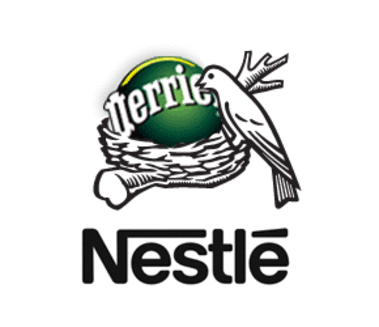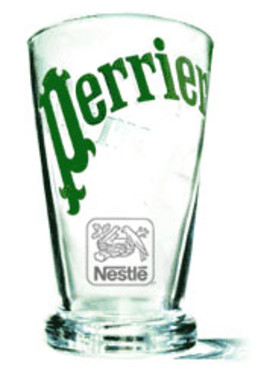Perrier: Nestled in controversy?
November 8, 2004 - Brandchannel.com

It’s a quintessential Gallic battle in the South of France. For the past eight months, Perrier, a darling brand for decades, has been caught in the middle of a power struggle between an old-school labor union and a global mega-corporation in the form of its owner, Nestlé.
It ain’t pretty.
When the gloves come off, are the two sides dragging the green and yellow label around in the mud with them, or will it simply be blind market demand tied to the romantic idea of the brand that dictates future sales?
The struggle between the labor union—the CGT (Confédération Générale du Travail) and Perrier’s parent company, the Swiss-based Nestlé, often perches the fuzzy bottled water’s image on a high wire while they duke it out below.
This dispute, the fourth major labor/management row since Nestlé bought Perrier in 1992, began in March 2004 and revolves around Nestlé‘s plan to force an early retirement for 356 workers at Perrier’s plant in the southern French town of Vergèze, while simultaneously pushing for a threefold increase in their productivity.
The CGT, on the other hand, clings to the idea that things can remain as close as possible to the pre-Nestlé status quo and fights back accordingly.
Prior to Nestlé‘s buyout, Perrier was managed by Gustave Leven, who ran the company like a parent, going as far as creating low-price stores for his employees to shop at and pushing to create the nearby plant where Perrier still makes its hallmark green glass bottles. Many of the employees at Perrier who are looking at an early retirement are the ones who worked under Leven, and their children now make up an important hunk of Perrier’s current employees.
The pattern in the 2004 dispute seems to be that the union brings negotiations to a standstill, then Nestlé talks of selling them off or bottling “Perrier” in countries outside of France.

The latter idea throws purists in origin-conscious France into a tizzy and could explain why Nestlé has yet to follow through on that threat.
“It would be like making Bordeaux in Czechoslovakia!” says Georges Lepré, the one-time sommelier at the Ritz Hotel in Paris. “It’s unthinkable!”
A vociferous reaction like this seems almost predictable coming from someone who has dedicated his life to understanding beverages and their relation to French culture and identity. However, some market analysts agree with Lepré.
“Taking it outside of France is a big risk,” says Stephen Williamson, research manager at Euromonitor International, a London-based market research firm. “Finding out it is produced in the Czech Republic [rumors have circulated that Nestlé would like to produce Perrier in Eastern Europe or Asia] would be a huge problem for Perrier’s French market,” he says. “The only way they could overcome that one would be putting a lot of money into it.”
Benoit Moreau, bottled water specialist and editor-in-chief of the French drink trade monthly, Rayon Boissons (Drink Aisle) agrees that moving production outside of France won’t work, “You kill the brand. You kill Perrier in France.“Perrier: Nestled in controversy?
“It’s a big bluff,” he says.
With 55 percent of Perrier’s consumers in its homeland and its biggest markets among an older, more origin-conscious clientele, the idea of moving the production outside of the country is nothing to snicker at. Perrier produces 860 million bottles annually, and though it doesn’t release the numbers for Perrier alone, its French parent company, Nestlé Waters France, a conglomerate of 77 different brands, posted sales of 8.1 billion Swiss francs (US$ 6.5B/€ 5.3B) in 2003.
In the US, though, the carbonated water market as a whole is growing at a much slower rate than that of “still” bottled water. It was only in 2003 that Perrier was able to begin teetering around the break-even mark, following the 1990 recall of 280 million bottles after trace amounts of the carcinogen, benzene, were found in its water. That incident cost Perrier almost US$ 200 million (€ 155M), shattered its image and opened the door to Nestlé‘s purchase and the arrival of other competitors into the market.
Moreau also takes into account Perrier’s French consumers. Outside of the country, the green glass bottle is a symbol of luxury; within France, it’s a mixed bag. Though it has lost some of its cachet in France, becoming more of a mass-market drink than one consumed by society’s elite, its biggest markets are still in the north and west of the country where the relatively older drinkers are still origin-conscious.
“It would definitely have an impact on the French market if they made it elsewhere,” says Gary Hemphill, senior vice president at Beverage Marketing Corporation, a New York research and consulting firm.
Though Perrier has what Hemphill refers to as a “transporting imagery,” he’s not convinced that either the struggle between the two sides or where the water is bottled will make much difference on the world market.
“Some people who buy Perrier might imagine themselves sitting in a café on the Champs Elysées, but [Nestlé] can probably work around that,” he says, “but if people like a product, does the union and the [parent] company not getting along make much difference? “
Though the CGT did not return numerous phone calls for this piece, Nestlé seemed to agree with this line of thought.
“There is no negative effect on the sales,” says Hubert Genieys, external communications director for Nestlé Waters, the French-based holding company that owns Nestlé Waters France.
“I think that each consumer reading [daily stories about the CGT/Perrier struggle] is really able to differentiate the messages and to consider that there is absolutely no link in this issue with the quality image of the product,” says the spokesman.
As for a happy ending to the CGT/Perrier rift, Genieys takes a Swiss-style, numbers-first approach, “We don’t want to be happy, we just want to be ready to react efficiently to a very stringent competitive environment.”
Though Genieys clearly states that Nestlé‘s goal for Perrier “is not to produce it elsewhere,” he places productivity and efficiency over everything. “If we don’t succeed, we will need to think of other hypotheses,” he says, “Anything is possible.”
Joe Ray is a Paris-based freelance journalist specializing in food, travel and analysis pieces. He writes for major dailies and magazines around the world. His work can be found on www.joe-ray.com.